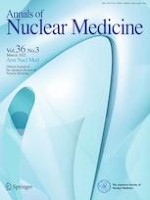26.11.2021 | Original Article
Feasibility of 125I-RGD uptake as a marker of angiogenesis after myocardial infarction
Erschienen in: Annals of Nuclear Medicine | Ausgabe 3/2022
Einloggen, um Zugang zu erhaltenAbstract
Objective
Angiogenesis is an important process facilitating the healing process after myocardial infarction. 125I-RGD imaging may be a promising candidate to image angiogenesis but may also detect inflammation.
Methods
Left coronary artery was occluded for 30 min, followed by reperfusion in a rat model (n = 31). One, 3, 7 and 14 days, 1 and 2 months later, Triple-tracer autoradiography was performed. 125I-RGD (1.5 MBq) and 201Tl (15 MBq) were injected at 80 and 10 min before sacrifice. Left coronary artery was reoccluded and 99mTc-MIBI (150–180 MBq) was injected 1 min before sacrifice to verify the area at risk. Angiogenesis and macrophage infiltration were evaluated by immunohistochemical analysis with anti-alpha-smooth muscle actin and anti-CD68, respectively.
Results
125I-RGD uptake ratio in the area at risk was weak at day 3 (1.23 ± 0.23 but increased markedly and peaked at day 7 (2.27 ± 0.37) followed by a gradual reduction until 1 and 2 months later (1.93 ± 0.16 at 1 month, 1.58 ± 0.15 at 2 month). In the immunohistochemical analysis, copious staining of anti-CD68 cells was observed, with anti-SMA cells stained only minimally at day 3. The number of anti-CD68 cells was decreased significantly at day 7 but largely absent at 1 month. Anti-SMA positive cells peaked at day 7 and reduced gradually until 1 month.
Conclusions
Myocardial 125I-RGD uptake reflects angiogenesis rather than inflammation after myocardial infarction.
Anzeige











